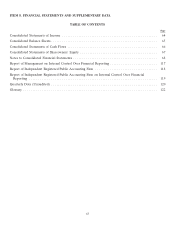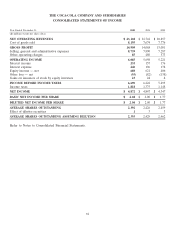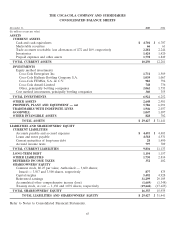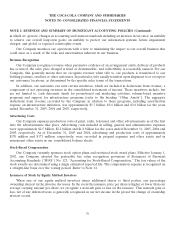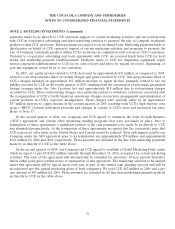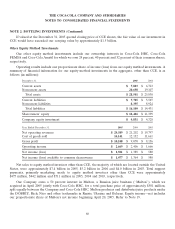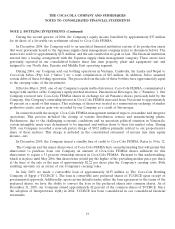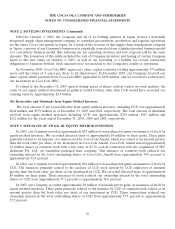Coca Cola 2005 Annual Report Download - page 74
Download and view the complete annual report
Please find page 74 of the 2005 Coca Cola annual report below. You can navigate through the pages in the report by either clicking on the pages listed below, or by using the keyword search tool below to find specific information within the annual report.THE COCA-COLA COMPANY AND SUBSIDIARIES
NOTES TO CONSOLIDATED FINANCIAL STATEMENTS
NOTE 1: BUSINESS AND SUMMARY OF SIGNIFICANT ACCOUNTING POLICIES (Continued)
Inventories
Inventories consist primarily of raw materials, supplies, concentrates and syrups and are valued at the lower
of cost or market. We determine cost on the basis of average cost or first-in, first-out methods.
Recoverability of Equity Method and Cost Method Investments
Management periodically assesses the recoverability of our Company’s equity method and cost method
investments. For publicly traded investments, readily available quoted market prices are an indication of the fair
value of our Company’s investments. For nonpublicly traded investments, if an identified event or change in
circumstances requires an impairment evaluation, management assesses fair value based on valuation
methodologies, including discounted cash flows, estimates of sales proceeds and external appraisals, as
appropriate. We consider the assumptions that we believe hypothetical marketplace participants would use in
evaluating estimated future cash flows when employing the discounted cash flows and estimates of sales
proceeds valuation methodologies. If an investment is considered to be impaired and the decline in value is
other than temporary, we record a write-down.
Other Assets
Our Company advances payments to certain customers for marketing to fund future activities intended to
generate profitable volume, and we expense such payments over the applicable period. Advance payments are
also made to certain customers for distribution rights. Additionally, our Company invests in infrastructure
programs with our bottlers that are directed at strengthening our bottling system and increasing unit case
volume. When facts and circumstances indicate that the carrying value of the assets may not be recoverable,
management evaluates the recoverability of these assets by preparing estimates of sales volume, the resulting
gross profit and cash flows. Costs of these programs are recorded in prepaid expenses and other assets and
noncurrent other assets and are being amortized over the remaining periods to be directly benefited, which
range from 1 to 13 years. Amortization expense for infrastructure programs was approximately $134 million,
$136 million and $153 million for the years ended December 31, 2005, 2004 and 2003, respectively. Refer to
heading ‘‘Revenue Recognition,’’ above, and Note 2.
Property, Plant and Equipment
Property, plant and equipment are stated at cost. Repair and maintenance costs that do not improve service
potential or extend economic life are expensed as incurred. Depreciation is recorded principally by the
straight-line method over the estimated useful lives of our assets, which generally have the following ranges:
buildings and improvements: 40 years or less; machinery and equipment: 15 years or less; containers: 10 years or
less. Land is not depreciated, and construction in progress is not depreciated until ready for service and
capitalized. Leasehold improvements are amortized using the straight-line method over the shorter of the
remaining lease term or the estimated useful life of the improvement. Depreciation expense totaled
approximately $752 million, $715 million and $667 million for the years ended December 31, 2005, 2004 and
2003, respectively. Amortization expense for leasehold improvements totaled approximately $17 million,
$7 million and $7 million for the years ended December 31, 2005, 2004 and 2003, respectively. Refer to Note 4.
Management assesses the recoverability of the carrying amount of property, plant and equipment if certain
events or changes in circumstances indicate that the carrying value of such assets may not be recoverable, such as
a significant decrease in market value of the assets or a significant change in the business conditions in a
particular market. If we determine that the carrying value of an asset is not recoverable based on expected
72



